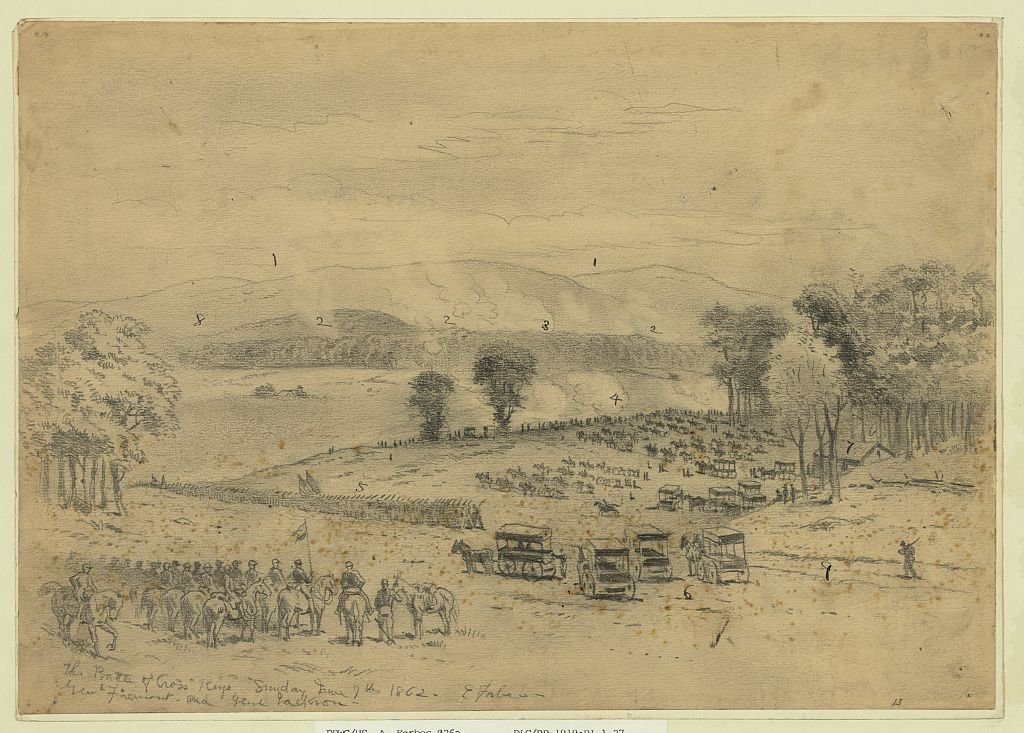
The Battle of Cross Keys
June 8, 1862
“There in the clover lay most of the 8th New York.”
At the Battle of Cross Keys, the penultimate clash of Stonewall Jackson’s Valley Campaign, Confederate troops under Gen. Richard Ewell defeated Union Gen. John C. Fremont, setting the stage for Jackson to move against another Union force at nearby Port Republic the next day.
Burning Bridges
After his victory at First Winchester on May 25, 1862, Confederate Gen. Stonewall Jackson advanced to the Potomac River at Harpers Ferry, then had to hurry south to avoid being cut off by two Union armies – narrowly escaping the converging Federal forces as he passed through Strasburg on June 1, then continuing to march his army hard southward up the Valley. Union Gen. John C. Fremont (15,000 men) followed in pursuit along the North Fork of the Shenandoah, west of Massanutten Mountain, while Gen. James Shields’ division (3,500 men) marched up the South Fork through the Luray Valley, east of the mountain. In an attempt to keep these forces from uniting, Jackson ordered the burning of numerous bridges along both rivers. When he reached the end of Massanutten, where the mountain would no longer separate the Union columns, he decided to make a stand before they could unite against him.
The Death of Ashby
On June 6, two days before Cross Keys, Confederate cavalry leader Gen. Turner Ashby was killed in a skirmish at Chestnut Ridge, just outside of Harrisonburg. The loss of the famed Ashby, “The Black Knight of the Confederacy,” was deeply felt. Capt. Campbell Brown remembered that, “Later in the evening I saw a party of cavalry pass by with Ashby’s body, crying, most of them, like children.”
Sketch of skirmish at Chesnut Ridge near Harrisonburg
Confederate Gen. Turner Ashby
“As a partisan officer I never knew his superior.” Stonewall Jackson said of Turner Ashby after learning of his death – though Jackson often clashed with Ashby over the latter’s loose approach to discipline.
The Battle
When Jackson reached Harrisonburg at the end of Massanutten Mountain, he turned southeast towards Cross Keys and Port Republic. He saw Port Republic, a small hamlet at the southern end of the Massanutten, as an ideal place to stand and fight. By controlling the only bridges that spanned the South Fork here, Jackson could prevent the Union columns from combining, enabling him to strike at each separately. As Fremont was closer, Jackson’s plan was to attack and overwhelm him first, and then turn back to defeat Shields. While preparing to engage Fremont at Cross Keys early on the morning of June 8, however, Jackson was surprised and almost captured by a Union raiding party at Port Republic.Shortly after, Fremont attacked Confederate Gen. Richard Ewell’s division at Cross Keys. An early Union advance was repulsed as it stumbled into a Confederate ambush, which decimated the 8th New York. Gen. Isaac Trimble’s Confederate brigade followed up their success by pressing the Union left and threatening its artillery supports. At this point Fremont’s nerve gave way – despite promising progress by Gen. Robert Milroy on the Federal right – and he ordered a general withdrawal. Darkness soon ended the fighting, with the Confederates holding the field – and the Union columns still separated. Jackson now turned his attention back to Shields, whom he would attack the next day at Port Republic.
Click the image to view the full-sized battle map
Click the image to view the full-sized battle map










